Frances Denney (post 1945)
Continued from: Frances Denney
By 1945, the management of Frances Denney had passed into the hands of the next generation. Anna and Helen Denney had died without offspring but William Denney had four children – William Denney Jr., John Denney, Anthony Denney, and Anna Fleming (née Denney). William Denney Jr. appears to have joined the company in 1928 with his brothers and sister following him during the 1930s. William Denney Jr. became the new company president after his father retired from that position with Anne Denney Fleming made the company treasurer.
Life for small-to-medium-sized cosmetic companies became more difficult after the war. Government regulation, rising consumer expectations for skin-care cosmetics, the development of new types of make-up, the growing youth market, and the arrival of television were just some of the factors that affected the fortunes of France Denney.
Skin-care
Despite the fact that many of its clients were ageing, Frances Denney does not seem to have added hormones to any of its skin-care cosmetics and made very little use of vitamins. However, it did add a number of other ‘wonder ingredients’ to its skin-care cosmetics starting with royal jelly. The company continued to stress the need for oils to keep the skin ‘moistened, soft and younger looking’, something it had been doing with its ‘lipoid rich’ Oils of the Wilderness before the war but this became less important during the 1960s following the arrival of the moisturiser.
Cleansers
In 1947, Frances Denney added two liquid cleansers to its skin-care range – Liquid Creme Cleanser, and Liquid Amber Cleanser. These were followed by Deep Down Cleansing Cream, a foaming cleanser, in 1950.
Liquid Creme Cleanser: “Wax free. Smooth as satin. A joy to use because it’s so quick . . . so dainty. And so little works such wonders.”
Liquid Amber Cleanser: “Clear, golden, so thorough, so refreshing. For all types of skin. Wonderful for adolescent and sensitive skin.”
Deep Down Cleansing Cream: “[F]oams away every trace of make-up in one clean sweep! No tiny particles left to clog the pores. Its deep down foaming action leaves the skin cleaner, softer, clearer than ever before.”
Blemish treatments
Cleansing the skin to ‘clean clogged pores’ was an important part of any blemish control treatment but Frances Denney also added a number of specific blemish treatments during the 1950s including Beautifying Lotion (1951), Formula A-B-C (1952), and the Visible Pore Kit (1956).
Beautifying Lotion was developed to treat coarse skin, enlarged pores and other surface irritations. It was recommended to be used twice a day, at night after completing a normal beauty routine, and again in the morning before applying a make-up foundation. I have been unable to determine its composition but it was suitable for all types of skin, dry, oily and even sensitive.
Beautifying Lotion: “[C]oarse skin, enlarged pores, surface irritations seem to smooth away. The skin looks fine-grained, alive with a younger appearance. This … lotion wakes up dull, sleepy skin and helps clear up roughness and surface blemishes. It brings smoother, clearer fineness to the texture of the skin.”
Formula A-B-C, was described as a skin ‘normaliser’ that could restored the acid balance of the skin.
When the acid of the skin is ether “plus’ or “minus’—beware!. Your beauty can be marred and your lovely complexion may vanish. Then you must find the secret of normalizing.
(Frances Denney advertisement, 1952)
See also: Acid Creams
It is possible that the formulation of Formula A-B-C changed following its introduction as it was first described as violet coloured but became pink by 1953. It appears to have been medicated as it was said to clear the blemishes, pimples, whiteheads, and irritation caused by ‘acid-bacteria’. I have no information on the active ingredient.
Formula A-B-C: “[C]omforts irritated skin, helps rebalance the ‘acid-bacteria’ condition.”
Frances Denney created two kits using Formula A-B-C in 1954. The Face Lifting Kit which combined Deep Down Cleansing Lotion, Formula A-B-C, and Invisible Beauty Strap, and the Viva Treatment Kit containing Formula A-B-C, and Viva Cream. A third blemish-control combination was developed without Formula A-B-C in 1956. Called the Visible Pore Kit, it consisted of three new products – Visible Pore Cleanser, Visible Pore Pack, and Visible Pore Astringent.
Visible Pore Kit: “The first time you use this treatment you’ll see and feel a wonderful difference in your skin. After faithful care you’ll notice how your skin glows with a new kind of freshness and cleanliness. Pores will appear smaller, the skin will feel tightened in contour.”
The Frances Denney 15-minute Visible Pore Kit treatment for blemished skin was as follows:
First: cleanse your skin with the Visible Pore Cleanser, you’ll feel it listening and freeing dirt and grime that provoke blackheads, large pores and surface blemishes.
Next: apply the Visible Pore Pack, it’s gentle, yet “lifts out” residue from pore openings . . . blackheads “float away” when you rinse off the masque with plain water.
Lastly: soothe and smooth your skin with the Visible Pore Astringent.(Frances Denney advertisement, 1956)
Contour treatments
Frances Denney added to its existing lines for the neck and throat with Neck and Contour Blend (1947). This is also when I find the first references to Frances Denney treatments employing a chin strap, something others had been recommending for decades.
Neck and Contour Blend: “To help keep your throat line young and beautiful … helps in areas where muscles tend to sag where a cream is truly put to the test. Pat, pat, pat it on and joy in the new loveliness it helps your neck and throat attain.”
Contour Chin Strap: “A corrective chin strap that really looks lovely and feels lovely! Made of washable plastic that will not stretch, shrink or lose its shape. Cleverly shirred to fit the contour of your face . . . comfortable and adjustable.”
See also: Straps, Bandages and Tapes
In 1949, Frances Denney combined the Neck and Contour Blend and the Contour Chin Strap with its prewar Special Astringent to produce the Neck and Contour Treatment Kit. Included in the box was a set of neck exercises to strengthen the muscles of the throat.

Above: 1950 Frances Denney can solve your most vexing beauty problems. Neck and Contour Treatment Kit bottom right.
In 1951, Frances Denney added Invisible Beauty Strap, one of many contour lotions introduced by beauty companies during the 1950s. Applied over the throat it produced a tightening sensation which made it appear that the preparation was lifting the throat. It was heavily advertised and sold well. Frances Denney claimed to be the first company to introduced this type of cosmetic into the American market. Although earlier than many other brands this was clearly not the case as Delettrez Liquid Chin Strap was available before America joined the Second World War.
Invisible Beauty Strap: “To work against age and surface lines. A flowing transparent cream that seems to sooth [sic] new beauty into your skin . . . a bracing, firming, lifting feeling as it works against that tired look which gives raging contour to your face. Helps smooth out little jaw-line puffiness, little mouth-to-nose lines.”
See also: Chin and Throat Treatments
In 1954, Frances Denney combined Invisible Beauty Strap with a lotion called Diet-Form, a bottle containing 80 vitamin-bolstering and appetite-curbing Slim-Trim tablets, and some information on dieting to form the Frances Denney Slim-Trim Treatment. Like the Invisible Beauty Strap, Diet-Form was also said to firm and tighten the skin but claimed to do so over the whole body.
Diet-Form: “[H]elps firm ‘skin-sag’ which tends to appear as you lose weight. … [A] must for every woman, on a diet or not, who wants to keep a firm, smooth, youthful looking body.”
Moisturisers
Frances Denney debuted its Multi-Layer Moisturiser in 1956 as a night cream or applied under make-up. It arrived after Irvin Blank [1902-2000] published his articles on the moisture content of the outer layer of the skin, the stratum corneum, in the early 1950s. However, rather than hydrating the surface of the skin in the manner outlined by Blank, Multi-Layer Moisturiser was claimed to penetrate deep into the skin to increase sub-epidermal hydration.
Multi-Layer Moisturizer: “[P]enetrates deep, deep into your skin to enrich and protect against drying and ageing.”
Before Blank’s experimental work, dry skin was generally thought to be due to a lack of oil not water, the oils having a softening effect on the skin, something Frances Denney clearly followed. Concerns about water were usually related to moisture deep in the skin not the surface layer and this was the reasoning followed by Frances Denney when it released Multi-Layer Moisturiser.
See also: Dry Skin Treatments
This suggests that, like Flowing Velvet Lotion (Jacqueline Cochran, 1949) and Formulayer Moisture Cream (Harriet Hubbard Ayer, 1950), Frances Denney released Multi-Layer Moisturizer as a substitute for a hormone cream, a cosmetic Frances Denney did not make. Cosmetics containing hormones were very common in the 1950s and were thought to produce a more youthful-looking skin by increasing the skin’s sub-epidermal moisture content.
See also: Moisturisers
When Frances Denney released Viva (1953), its new night cream, advertisements for the product still followed the pre-Blank idea that oils were needed to combat and soften dry skin and diminish wrinkles.
Viva perks up the slackness of tired, tense skin. Viva acts to restore the youthful elasticity of the skin. A lifeless looking skin will appear to have new life. Viva can help you look younger. You do not have to leave this exciting new cream on overnight. Viva can do its important work in a half hour. Viva works wonders for all types of skin—and it can unhesitantly be used by those many, many women who have dry skin or sensitive skin. The oils in Viva are so combined that the skin is soothed and softened and smoothed. A sensitive skin responds to the soothing effects of Viva—the lubricating qualities of Viva discourage dryness and that stiff, dry, wrinkled feeling disappears.
(Frances Denney advertisement, 1953)
When the company’s position on the causes of dry skin later took Blank’s research into account both Viva and Multi-Layer Moisturizer were then promoted more like modern moisturisers. However, some product descriptions still had an each-way bet, oils to smooth and water to retain moisture.
Viva Cream: “With just thirty minutes a day you can make this silken cream your weapon to help guard against dry skin, ageing lines. It helps top smooth the complexion . . . and to retain the natural moisture that gives your skin a younger, fresher bloom.”
Viva Liquid arrived in 1954 with the company packaging it in a meter-top bottle in 1963.
Now—the make-up with the allure that is famous for its sheer natural beauty, its luminous coverage, its lasting matte finish—comes in a new meter-top bottle that doles out precious drops of color . . . drop by drop . . . just as you need it.
(Frances Denney advertisement, 1963)
When Viva Super Masque was introduced in 1955, its moisturising properties were highlighted along with its skin firming features. It was enriched with vitamin A, one of the most commonly used vitamins found in vitamin creams before the arrival of vitamin E and the only case I have found of Frances Denney mentioning a vitamin. Packaging for the products was unconventional, with thirty individual treatment tubes of Viva Super Masque sold a five drawer, gold box container.
Viva Super Masque: “This magical beautifier, enriched with Vitamin A, tightens and firms your skin . . . its effects are so lasting, you need apply it only every other day. … [H]elps retain the natural moisture of your skin, so essential for fresh, younger looking beauty.”
Royal Jelly
In 1957, Frances Denney joined the royal jelly craze, a French idea brought to America by brands such as Orlane, Alexandra de Markoff, and Marie Earle. As well as adding it to a number of existing skin-care lines the company also created a new skin-care cosmetic with it – Creme Supreme.
Creme Supreme with Royal Jelly: “A new rich cream with Royal Jelly for the dry and sensitive skin that needs calm, soothing lubrication. It is absorbed deep into the skin.”
Like other cosmetics using royal jelly, the additive was justified by its supposed life-extending properties which Frances Denney put down to an unnamed vitamin.
The source of the extraordinary power of Royal Jelly lies mainly in its high concentration of vitamins . . . including the vitamin especially associated with the prolongation of life. It is also very rich in proteins and minerals. Frances Denney so believes in the power of Royal Jelly she has added it to her preparations in the highest potency.
(Frances Denney advertisement, 1957)
Exisitng Frances Denney skin-care lines that had royal jelly added to them were as follows:
Viva with Royal Jelly: “The magnificent lubricating cream now made even more effective with Royal Jelly. Its original biogenic formula is absorbed deep into the skin and activates the living processes of the skin cells.”
Eye Cream with Royal Jelly: “The action of Royal Jelly encourages natural cell function and gives the needed corrective care for the thin, fragile skin of the eye area. Helps correct aging signs.”
Multi-Layer Moisturizer with Royal Jelly: “For the dehydrated skin! Royal Jelly makes this famous formula extra-effective in giving the skin deep-down moisture.”
Neck and Contour Blend with Royal Jelly: “The action of this famous preparation is speeded with Royal Jelly, encouraging natural cell function and surface circulation. Helps the neckline to be tight and firm.”
Invisible Beauty Strap with Royal Jelly: “Acts like a ‘face-lift’ under make-up. Almost instantly the contour feels braced, firmed, lifted; lines seem to disappear – aided by Royal Jelly.”
Other items
Creme Tranquilease (1958) got the company into trouble with the Federal Trade Commission (FTC) after it claimed to be the ‘only cosmetic tranquilizer for the skin’.
Creme Tranquilease: “[F]or the tense lines of strain the drawn skin of nervousness the tired skin of fatigue.”
Analysis by the FTC showed that Tranquilease was an oil-in-water emulsion containing mineral oil, glycerol, glycerol monostearate, waxes including lanolin, pigments such as zinc oxide and titanium dioxide and a nitrogen compound that was probably an amine. The FTC’s main complaint was the way it was promoted. A cream that claimed to correct skin problems caused by ‘emotional upsets, tension and fatigue’ sounded too much like a drug.
The last skin-care cream Frances Denney introduced in the 1950s was One Touch of Glamour (1959). It was used under make-up to moisturise, and reduce winkles but, being matt, it also reduced shine. Frances Denney also referred to it as a ‘facial anti-perspirant’ in early advertisements but this claim disappeared fairly quickly.
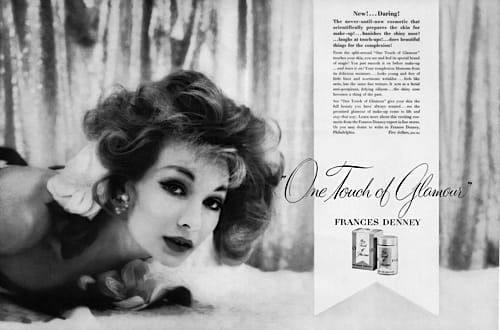
Above: 1959 Frances Denney One Touch of Glamour.
One Touch of Glamour: “The wonderful new cosmetic you just smooth on before make-up to prevent a shiny nose, to laugh at touchups! Your skin will be dewy-fresh, petal-smooth; it acts as a facial anti-perspirant.”
Make-up
A number of new types of make-up were introduced after the war and Frances Denney made good use of some of these new forms, particularly liquid and pressed powders. The company’s make-up shade ranges continued to be limited which became more of a problem as shade ranges by the majors increased dramatically after the war. This may be why Frances Denney advertisements tended to rely on phrases such as ‘in a choice of shades’ ‘radiant shades for every complexion’ or ‘exquisite shades’ rather than list available colours. Promotional campaigns for new Frances Denney shades were also uncommon with the company generally using its advertising budget to focus on the emotional impact of its make-up.
Foundations and powders
In 1946, Frances Denney introduced two new foundations – Luminous Film, a cream foundation, and Luminous Cover-up, a liquid foundation, along with Neck Blender, a liquid make-up for the neck and other exposed body parts. All these cosmetics came in the same four shades. I have no listing of these shades but my guess would be that they were the same as those found in Under-Tone – Soft, Deep, Brilliant, and Argentine – as a fifth shade, Ethereal, was added to all four products later in the year.
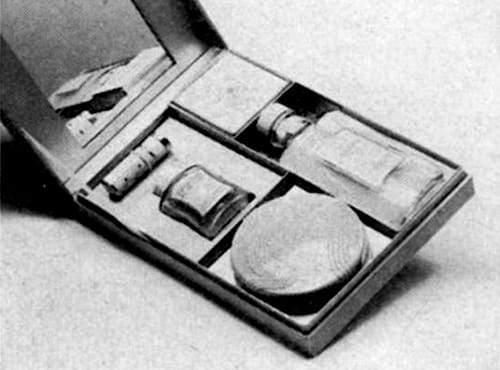
Above: 1949 Frances Denney Ethereal Make-up Box with mirror containing Ethereal Lipstick, Face Powder, Luminous Cover-up, Over-Tone, and Neck Blender.
Luminous Film: “[F]or the dewy look. Cream cover-up for a luminous finish. Gives smooth, even coloring; covers blemishes. Can be used on either dry or oily skin—does not reappear on the skin.” Four shades.
Luminous Cover-Up: “[F]or the luscious look. A liquid cover-up for a luminous finish. Covers blemishes, can be used on dry or oily skin, does not reappear on skin.” Four shades.
Neck Blender: “[M]ake-up for the neck that does not rub off on clothes. Blends beautifully on the neck, arms and shoulders and décolleté fashions.” Four shades.
Over-Tone, the cake make-up Frances Denney released in 1941, came in a wider shade. Repackaged in 1945, it came in eight colours by 1946 including Soft, Deep, Brilliant, Argentine, American Blend, Whirlwind, and Romance, with Ethereal added later in the year.
Frances Denney introduced a purse-sized version of Over-Tone in 1948, along with Foundation Make-up Wafer, a compressed cream make-up. This new type of make-up became very popular after the war, largely replacing the use of the pan-cake types like Over-Tone which many women found ‘drying’.
Foundation Make-up Wafer: “For the new soft look of beauty! Cream Foundation! Covers blemishes. Keeps make-up fresh looking! Adds beautiful color! A new carry-everywhere wafer size.”
Foundation Make-Up Wafer appears to have been superseded by Satiny Touch-Up (1953), packaged in a jet-black, mirrored case with gold leaf design. Again, I have no record of the shade range when it was introduced.
Satiny Touch-Up: “[A]dheres beautifully, never, never steaks. It is non drying to the skin. A texture so fine you obtain the covered powdered look.” Six shades.
Other foundations/make-up bases later added by Frances Denney in the 1950s were Texture Tint (1950), and Viva Fluid Make-Up (1955). Texture Tint was an oil-based suspension described as a half texture lotion, half foundation that needed to be well shaken before it was applied.
Viva Fluid Make-Up was made with a base of Viva Lotion and came in seven shades, increased to twelve by 1957. I have no record of the original colour range but imagine that some may have been at the same as those developed for Texture Tint. The only shades I have records for through to 1960 are Rose Beige, Golden Glow, American Blend, and Light Hearted.
Texture Tint: “A creamy liquid that stays on all day without touch ups. Not necessary to use face powder. Smooths tiny lines instead of covering them.” Shades: Golden Rose, Rose Beige, Pink Watermelon, Soft Blend, Rose, and Beige, with Highlight added in 1952.
Viva Fluid Make-Up: “ This make-up won’t fade or darken under brilliant sunlight or artificial light . . . it gives you ‘constant color’ under any light. Enriched with Viva, the famous beauty cream, this make-up helps retain the natural moisture so essential to a younger-looking complexion.” Seven shades.
Viva Fluid Make-Up was promoted as having ‘constant color’; i.e., it would remain the same under different lighting conditions. This idea was also extended to Constant Color Lipstick, and Constant Colour Face Powder both also released in 1955.
Now you do not need a different shade for night and day. You can choose your “Constant Color” shade to flatter your complexion and your costume—not because of the way it acts under different light.
(Frances Denney advertisement, 1955)
Royal Jelly
When Frances Denney developed some royal jelly skin-care cosmetics in 1957 it also created royal jelly make-up. This consisted of Over-Tone Cake Make-up with Royal Jelly, a range of Royal Jelly Lipsticks, and a new foundation, Fluid Cream Make-up with Royal Jelly.
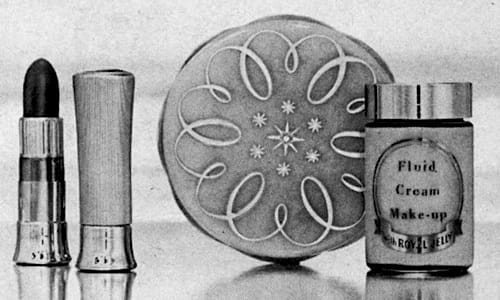
Above: 1958 Frances Denney Lipstick with Royal Jelly, Overtone Cake Make-up with Royal Jelly, and Fluid Cream Make-up with Royal Jelly.
Lipstick with Royal Jelly: “[S]o lasting and not drying.”
Fluid Cream Make-up with Royal Jelly: “[N]ot a fluid, not a cream, but an entirely new foundation that defies comparison.”
Over-Tone Cake Make-Up with Royal Jelly: “[T]he new glamorous cover-up that lasts for hours, cannot dry the skin.”
Lipsticks
By the end of the Second World War, Frances Denney was selling indelible lipsticks in modified Starglow cases in twelve shades – Derby Red, Knockout Red, Independence Red, Night Club, Watermelon, Cinnamon Stick, American Blend, Paris Blend, True Red, Argentine, Allegiance Red, and Whirlwind. Other shades available up to 1950 that I know of were Red Lilac, Coral, Cyclamen, Pink Watermelon, Pink Splendour, and Ethereal.
In 1951, Frances Denney produced a new Lipoid Lipstick in a gold-plated, refillable case that had some similarities to the original Starglow case design. It came in six shades the only one I can verify being Night Club, first used back in 1939.
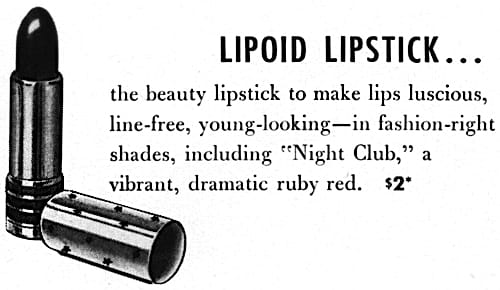
Above: 1951 Frances Denney Lipoid Lipstick.
When introducing the Lipoid Lipstick, Frances Denney may have been trying to capitalise of the promotional work it had already done with lipoids in its Oils of the Wilderness, the high-priced skin cream it had been selling since 1933. Unfortunately, this new creamy lipstick arrived shortly after Hazel Bishop introduced her Long Lasting/No-Smear Lipstick. The Hazel Bishop lipstick sparked a renewed interest in indelibles and kick-started what became known as the American Lipstick Wars.
See also: Lipstick Wars
The arrival of Hazel Bishop’s Long Lasting/No-Smear Lipstick may have been the reason why Frances Denney added ‘Stay-On’ to a number of its advertisements for the lipstick, why the Lipoid Lipstick name was dropped fairly quickly, and why advertising for it seems to have ceased after 1951.
There is something new in lipstick, a corrective beauty lipstick, which gives the lips a beauty treatment and at the same time gives dramatic color, which stays on and on. Frances Denney “Stay-On” lipstick will make the lips smooth, soft and line-free. The secret of this is very simple. To her lipstick Miss Denney has added lipoids, the magical way of bringing younger-looking beauty to the skin. If you have the vexing beauty problem in Winter of chapped lips you’ll find this lipoid lipstick of great benefit.
(Frances Denney, advertisement, 1951)
In 1955, Frances Denney added the previously mentioned Constant Colour Lipstick in two forms – Regular and Super-Cream – in a largely unknown shade range. Following the Constant Color Lipstick came the already mentioned Frances Denney Lipstick with Royal Jelly (1957), a glossy lipstick in a new gold-plated, click-in refill case.
Constant Color Lipstick: “Rich true shades that stay the same glorious color under any light—in glaring sun or candleglow!” Twelve shades.
Frances Denney Lipstick with Royal Jelly: “This beauty treatment formula uses the incredible stay-on power of Royal Jelly to give this lipstick a cling that makes you forget touch-ups. Keeps lips soft, alive, protected. In an elegant 24k gold-plated case.”
As mentioned earlier, shade ranges for Frances Denney are very difficult to pin down and this applies to lipsticks as well. The only new shades I have been able to identify from 1950 through to 1960 are: Highlight (1952); Riviera Red and Enchanted Pink (1956); Imperial Red (1957); Red Lustre, Rose Lustre, and Ambre Lustre (1958); Gypsy Fire, Floradora Frill, Cherry Frappe, Strawberry Frappe, Peach Frappe, and Pearl Frappe (1959); and Lovelight (1960); as well as Coral, Rose Capri, Pink Cameo, and Flamingo Orange which are undated.
Shades introduced after 1957 are not necessarily found in both Constant Colour and Royal Jelly lipsticks. For example, Cherry Frappe, Strawberry Frappe, Peach Frappe, and Pearl Frappe only seem to have been available in Royal Jelly lipsticks. Introduction dates also vary. For example, Riviera Red appeared in Constant Colour Lipsticks in 1956 but only arrived in Royal Jelly lipsticks in 1957.
One last ‘lipstick’ added by Frances Denney in the 1950s was Lip Moisturizer (1959). Packaged in a lipstick case it could be used in isolation or under a lipstick as a lip protectant but could also be applied over a lipstick as a lip gloss.
Lip Moisturizer: “It helps make your lips look and feel beautifully soft, delightfully smooth. It helps take away dryness, too.”
Robert Denney
In 1961, Robert Denney, the eldest son of William Denney Jr., became the new president of Frances Denney after his father ‘retired’ and became chairman of the board. A graduate from the University of Pennsylvania, Robert Denney had joined Frances Denney in 1956 after leaving the Navy, having previously worked in newspapers and advertising. He would remain president of Frances Denney until the business was sold in 1974.
One of the first products developed under his watch was Mother-To-Be, a body lotion for use during the third month of pregnancy to help avoid stretch marks. It was sold through the company’s professional division.
In 1967, a men’s line was developed that was named after him. The range consisted of Robert Denney Lip Protector, After-Shave Skin Conditioner, Stick Deodorant, and Soap-on-a-Rope, some items fragranced with Chenango, introduced as an After-Shave Cologne back in 1964. Robert Denney Conditioning Face Bronzer, Hair Control Spray, and Spray Anti-Perspirant were added in 1968.
Skin-care
After 1960, Frances Denney stopped advertising its royal jelly jelly range and moved on to other things. This started with New Life (1961) a skin cream containing the scientific-sounding Bi-Nutriol 7, a ‘bio-complex’ said to make skin cells more receptive to other skin-cream nutrients by increasing their oxygen uptake. A small New Life series was later created – New Life Bath Oil in 1961, and then New Life Conditioning Shampoo, and New Life Hair Spray in 1965.
New Life: “This light, rich cream is delightfully absorbable. The exclusive oxygen-factor in New Life helps skin cells to help themselves to young beauty. Discover New Life and see how this synergetic beauty cream works to bring the bloom of youth to your skin.”
New Life was followed by Neo-Classic Night Cream (1963), and Source of Beauty (1964) both designed for dry skin types, so were probably aimed at Frances Denney’s ageing clients.
Neo-Classic Night Cream: “Even ultra-dry skin surrenders to this perfect marriage of modern research and classic richness. … [I]t melts into a clear transparency; leaves the complexion feeling pampered, protected, smoothed.”
Source of Beauty Cream: “[C]ombines the exceptional benefits of super-moisturisers, lavish lubricants and special derivatives to help correct dryness, ease fine lines and puffiness and to encourage elasticity.”
Source of Beauty was later expanded into the Source of Beauty Collection which became the premier product range for France Denney by the end of the decade. It included skin-care cosmetics, make-up and hair-care products.
See also: The Lovely American (c.1968)
Source of Beauty skin-care cosmetics started with Source of Beauty Throat Firmer, Flowing Masque, Cleansing Whip, and Eye Smooth in 1968, with Source of Beauty Exhilarating Lotion, a skin tonic, added in 1969.
Throat firmer: “An absorbable cream that works with super speed to smooth and form the neck and throat area. Light-textured, it can be worn under make-up to achieve the new look of youngness.”
Flowing Masque: “A fluid cream pick me up that goes to work in seconds to activate your complexion to fresh, glowing beauty.”
Cleansing Whip: “This light whip of cream cleanses away stale make-up and dirt in seconds.”
Eye Smooth “Rich, yet so light textured you can use under makeup for all day protection against age and laugh lines.”
Exhilarating Lotion: “A dual-purpose beauty lotion that is a stimulating finale to the cleansing routine as well as a delightful refreshing pick-up at any time.”
Blemish treatments
Frances Denney continued to promote Formula A-B-C for acid balance control and to soothe skin irritations including blemishes but added the Super Quick medicated treatment range for problem skins, and Cover-Up, a stick concealer in three shades.
The Super Quick series started with Quick Foam, a neutralized liquid gel cleanser, sold in tubes from 1962. Quick Foam was medicated in 1964 becoming Super Quick Foam and this was joined by Super Quick Bar, Super Quick Pack, Super Quick Lotion, and Super Quick Cream in 1968.
Super Quick Foam Cleanser: “It washes your complexion immaculately clean without drying or robbing your skin of its precious oils, without detergent sting.”
Super Quick Bar: “[A] transparent soap for thorough cleansing.”
Super Quick Pack: “[A] four-minute mask to purify oily or problem skin.”
Super Quick Lotion: “[A]n astringent to tighten pores and refine texture which can also be used as a face wash.”
Contour treatments
In 1963, Frances Denney updated its neck and throat treatments adding Neck and Contour Astringent, and Neck and Contour Lift. Used in combination with the Two-way Neck and Chin Strap and a few simple exercises, these were recommended to help keep the throat and neckline firm and young looking.
Neck and throatline that have lost their young, slender grace make a woman took far older than her years. To help keep this vulnerable area firm, sleek and young-looking, Frances Denney has developed an effective modern treatment. Pleasant and easy to use, it is for the woman who seeks to retain–or regain-a smooth, young facial contour. A few fun-to-do exercises are also suggested to help maintain muscle tone.
(Frances Denney advertisement, 1965)
The two preparations were used in combination. The Neck and Contour Astringent was applied first using a lotion saturated cotton pad patted along each side of the neck from the centre outward. The Neck and Contour Lift cream was then applied over the Neck and Contour Astringent in upward strokes.
Neck and Contour Astringent: “[T]ightens and tones the skin.”
Neck and Contour Lift: “[A] lubricating and firming aid in the form of a greaseless cream.”
In 1966, Frances Denney added a ‘lifting’ preparation for the face. Applied under make-up, Moisturizing Beauty Lift lotion was said to lift, firm and moisturise the face giving it a sleek youthful look.
Moisturizing Beauty Lift: “[T]akes your complexion in hand with quiet authority, gives it a gentle young-minded uplift even as it works a minor miracle, tightening, firming and easing away the fretwork of tired little lines. All this and moisture, too.”
Sun-care
After introducing Interlude Bath and Body Perfume in 1962, Frances Denney added a range of other products fragranced with Interlude including Interlude perfume (1967), Creme de Parfum, Perfume Cologne, Body Lotion, Body Oil, Body Powder, Beauty Bath, Bath Oil soap, and Dusting Powder.
See also: Frances Denney (c.1969)
One of the products in the Interlude series, Interlude in the Sun (1967), combined a protective suntan lotion with the fragrance of Interlude. It does not appear to have been successful with Frances Denney replacing it with the Dew Tan series (1969), three products that promised to moisturise as well as protect. Unfortunately, I do not know the nature of any ultraviolet (UV) blocker used in any of these products.
Interlude in the Sun: “[The] safe and scented approach to a beautiful tan unites a protective suntan lotion with the provocative fragrance of Interlude.”
Dew Tan Moisturizing Suntan Gel: “[F]or you who tan with beautiful ease.”
Dew Tan Moisturizing Suntan Cream: “[F]or the girl who takes the sun in measure doses.”
Dew Tan After-Sun Moisturizing Lotion: “[T]he refreshing lotion that smooths the way to the end of a perfect day for every body.”
Other lines
In 1962, Frances Denney introduced Fade-Away containing hydroquinone, a substance that inhibits the production of the skin pigment melanin, as the active depigmenting agent, currently banned in a number of countries. It would go on to become one of Frances Denney’s best sellers.
Fade Away: “[M]akes all the little brown spots like freckles and age spots, even the tan that a fading to an unglamorous yellow, fade away like magic! Gentle, made especially to correct hyperpigmentation.“
See also: Bleach Creams
Strictly for Girls After-Shave Spray debuted in 1963. Arriving a year before Frances Denney introduced its first men’s after-shave, it was lightly medicated to help soothe skin irritations.
Strictly for Girls After-Shave Spray: “[A]fter shaving, spray on this formula to smooth rough skin, soothe irritations.“
Make-up
Frances Denney continued to follow the pattern it had set down in the 1950s and only rarely posted records of its shade ranges. When it did so, these were generally used to show how to use Frances Denney make-up to create a particular ‘look’ that could be used by demonstrators to attract customers to Frances Denney counters in department stores.
Frances Denney make-up in the 1960s was broadly based around two new series – Lustrous Make-up and Incandescent make-up. The Lustrous Make-up range (1963) consisted of Lustre Glow Complexion Tint, Lustre Finish Powder, and Eye Lustre along with a number of lipsticks in lustre colours but relied on existing foundations such as Viva Fluid Make-up. Products from the range used to create the Touch of Gold Look (1964).
[T]his beautiful glow for day and night creates sheer flattery, a radiance of color filtered through sunlight. See the touch-of-gold for your complexion, iridescence for your eyes, lipstick alive with lustrous brightness. Frances Denney Lustrous Make-Up in Glowing Gold; Lustre Glow Complexion Tint; Lustre Finish Powder; Eye Lustre Shadow-In-A-Tube, Roman Gold; Lipstick, Golden Fire or Pink Gold.
(Frances Denney advertisement (modified), 1964)
The Incandescent series began with Incandescent Make-up (1965), another fluid foundation additional oils for dry skin. This was followed by Incandescent Lipstick (1966), Incandescent Glowlight (1967), Incandescent Finishing Powder (1966), Incandescent Eye Paints (1967), and Incandescent Lip Lights. These appear to have largely superseded the Lustrous range and were part of the previously mentioned Source of Beauty Collection. Incandescent Lipstick was also known as Source of Beauty Treatment Lipstick to stress its relationship with the Source of Beauty Cream.
Foundations and powders
As already noted, Frances Denney sold two main foundations during the 1960s, the older Viva Fluid Make-up (1955) and Incandescent Make-up (1965). Viva Fluid Make-up and the later Viva Fluid Make-up for Oily Skin had a matt finish while Incandescent Make-up came with an inbuilt lustre.
Viva Fluid Make-up: “[R]ich in moisture-protecting agents! Gives beautiful coverage. Veils your complexion with a long-lasting, lovely mist of colour, a soft, smooth, youthful radiance.”
Viva Fluid Make-up for Oily Skin: “Acts as a protector against excess oil which creates shine; will not streak or change colour. Provides sheer coverage, a look of fine texture.”
Incandescent Make-up: “[L]avish with the finest of delicate oils; superb for the dry complexion that needs added richness.” Six shades including Soft Bronze with Tender Light added in 1967.
Loose and pressed powders available during the 1960s included the earlier Over-Tone Cake Make-up, and Satiny Touch-up Pressed Powder as well as the new Royal Texture Face Powder, Royal Texture Pressed Powder, and the previously mentioned Incandescent Finishing Powder. Unfortunately, shade ranges for most of these powders are unknown.
Over-Tone Cake Make-up, and Royal Texture Pressed Powder appear to have been discontinued by the end of the decade.
Royal Texture Face Powder: “[T]the sheer, natural look in make-up for the individual who wants the subtle touch of a powder to finish off her make-up.”
Incandescent Finishing Powder: “[F]luffed on glamour. Powder so light and airy leaves you in just an aura of colour . . . sheer incandescent. With puff.” Known shades: Nude, Golden Glow, American Blend, Futura, Futura Rose, Misty Rose, Bronze, Rosita, Beige, Rose Beige, Golden Biscuit.
Two other make-up preparations of note were Play-of-Light (1963) and Bare Allusion (1967). Play-of-Light was a turquoise-tinted cream sold in tubes used to conceal blemishes and contour the face while Bare Allusion Leg & Body Make-up acted as a fake tan.
Play-of-Light: “A delicate turquoise cream that has uncanny ability to camouflage dark circles, fake away lines, re-shape a face. It gives the effect of trimming down a nose, highlights a chin, widens a jaw. Lights up the lovely things about you, plays down those you care for less.”
Bare Allusion Leg & Body Make-up: “Newer than nude, this makeup is a sleek sheath of color that covers you beautifully, so you dare a decollete, show a shoulder, a back, your midriff, your legs with complete composure. Smooths on like creamy satin. Won’t stain or rub off; it’s waterproof, yet rinses away with a gentle soaping.” Shades: Golden, Sun, Tan, and Bronze.
Lipsticks
I have found no mention of Frances Denney Constant Color Lipstick in the 1960s and the company also stopped mentioning Royal Jelly Lipsticks after 1961. New lipsticks included the cheaper Royal Texture Lipstick, the more expensive Incandescent Lipstick (1966) in fifteen shades, as well as clear Crystal Glazers Lipstick, and frosted Lamé Lipstick both available by 1968. All four lipsticks were housed in different refillable cases.
Royal Texture Lipstick: “[Wonderfully silken-textured, it gives a luscious glowing excitement to the lips.” Known shades: Breath-Taking Pink, and Breath-Taking Coral.
Incandescent Lipstick: “Luminous lips . . . shimmering with the dewiness of multiple moisturizers, awakened to a vivacious new beauty.” Fifteen shades. Known shades: Lustre Bronze, Lustre Red, Barely Pink, True Red, Go-Go Red, Hot Coral, Plum Biscuit, and Bronze Biscuit
Crystal Glazers Lipstick: “Sleek shining transparencies of color that glide on with a shimmering beauty, enchanting the lips with a crystal-clear lustre.” Shades: Apple Jack, Cherry Liqueur, Grenadine, Peach Brandy, Apricot Liqueur, Plum Brandy, Ginger Brandy, and Spanish Brandy.
Lamé Lipstick: “[T]he frosted lipstick . . . captivating accent, lipstick shimmering with the subtle glow of pearls. Lusciously creamy and smooth.” Shades: Lamé Café, Gold Lamé, Champagne Lamé
Shade ranges and dates for these lipsticks are largely missing. Those that I know of are: True Pink (1961); Golden Fire, Pink Gold, Misty Rose, and Misty Gold (1963); Breath-Taking Pink, Breath-Taking Coral, Go-Go Red, and Hot Coral (1965); Plum Biscuit, and Bronze Biscuit (1966); Magnet (1968); Marioca (1969); and Burnt Apricot (1970).
Eye make-up
Information Frances Denney eye make-up is very sparse. However, given the growing importance of eye make-up in the 1960s, the company did make more effort in updating and extending the range, adding its Enchanting Eyes series as part of its Contemporary Look in 1965. By 1967, the range included Cake and Stick Shadow, Cream Eyelash Make-up, Roll-On Mascara, Cake and Liquid Eyeliner, Brush-On Eyebrow Make-up, and Eye Beauty Pencil with Fashion Fringes false eyelashes added by 1968.
Liquid Eye Liner: “[D]ries in a wink, lasts through the longest day. Easy to apply with its own special brush.” Known shades: Black, and Brown.
Cake Eye Liner: “[D]rama for your eyes in a pressed powder. In compact complete with brush.”
Lustrous Cake Shadow: “[A]lluring color with a softly slowing lustre. Meant to bewitch the eyes, touch them with glamour. Color you ease on gently with a special sponge-tip applicator. In compact complete with applicator.” Known shades: Blue Sky, Turquoise, Emerald, and Ivory.
Cream Eyelash Make-up: “It’s a creme that you apply with a brush! Smooth and silky color to make your eyes more expressive.” Shades: Brown, Charcoal Brown, Black, and Silver Tip.
Roll-On Mascara: “[A] fine, automatic mascara to give the illusion of long, thick lashes. Won’t run. Can’t smudge. Doesn’t dry out. Waterproof, odorless.” Known shades: Black, Brown, and Charcoal Brown.
Eye Beauty Pencil: “[F]or accenting and shaping eyebrows and as an eye liner. Smooth, easy to handle.”
Brush-On EyeBrow Make-Up: “[E]asily, quickly, with just a touch of the special brush, shape and color eyebrows into a beautiful natural look. No harsh lines, no theatrical effect. In case with brush.”
Fashion Fringe: “[T]he most beautifully natural eyelashes ever. Of lustrous real hair, in two styles: Maxi Lash, for a lavish fringe, Mini Lash, for just a hint of fullness.” Shades: Black, and Brown.
Frances Denney also introduced Incandescent Eye Lights into its Incandescent range in 1967.
Incandescent Eye Lights: “A liquid formula which sets immovably dry. Each color may be used pure and gradually shaded into another or shades can be blended together to achieve an exact, customized tone which will not appear any heavier on the lid to give a soft, delicate, natural look.”
See also: Frances Denney (c.1969)
Colour coordination
As described earlier most new Frances Denney make-up added in the 1960s was introduced as part of a ‘look’ or ‘collection’. Examples included the Shibui Look (1961), the Misty Look (1963), the Contemporary Look (1965), The Breath-Taking Beauty Make-up Collection (1965), the Starglow Look (1967), and the Fashioning the Elegant Face (1968).
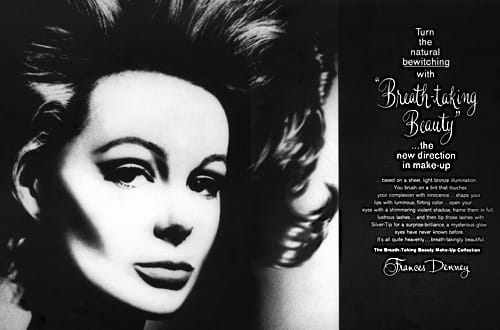
Above: 1965 Frances Denney Breath-Taking Beauty. Breathtaking Bronze Viva Fluid Make-up or Cake Make-up topped with companion Satiny Brush-On Tint. Eyes made up with French Violet Eye Lustre or Liquid Eye Make-up. Lips in Breathtaking Coral or Breathtaking Pink Glamour Texture Lipstick.

Above: 1968 Frances Denney Fashioning the Elegant Face. Viva Fluid Make-up or Incandescent Make-Up is illuminated using Incandescent Glowlight with Incandescent Finish Powder fluffed here and there for added allure. Lipstick choices include Magnet and Flair or perhaps Champagne Lamé
Later developments
By the 1970s Frances Denney was clearly in trouble, primarily because its clientele was not being replaced by new younger customers. Attempts had been made in the past to appeal to this group. Frances Denney had been advertising in youth magazines like ‘Mademoiselle’ for years and it continued to produce cosmetics it thought might appeal to younger women. For example, in 1970 it debuted a new range, all sold in tubes with the make-up given ‘hip’ shade names – Futura Five weightless make-up in four beige and three peach shades, Smooth Dew moisturiser, Sheer Bronze bronzing gel, and Cheek Gems blusher in shades such as Clover Pink Pearl, Posey Peach Pearl, Tiger Lily Tawny, and Planetary Pink.
Loosing money, a decision was made to sell, the new owners being the Berwind Corporation. William Fine became the new president of Frances Denney and his then wife, Susan Fine, was made the company’s creative director. She appeared in many Frances Denney advertisements giving the brand a more youthful appearance. According to most reports the new owners managed to turn Frances Denney into a profitable company once more.
William and Susan Fine divorced in 1980 and this may have precipitated Frances Denney being sold to Delalande, Inc. It was sold again in 1990 to Colonia Inc., an American subsidiary of Ferdinand Mülhens Parfumerie-Fabric, better know as the House of 4711. Following the sale, Frances Denney was rebranded as Trend Laboratories Inc.
Timeline
| 1946 | New Products: Luminous Film; Luminous Cover-up; and Neck Blender. |
| 1947 | New Products: Neck and Contour Blend. |
| 1948 | New Products: Magic Song Cologne Deodorant; and Magic Song Cream Deodorant. |
| 1950 | New Products: Texture Tint. |
| 1951 | New Products: Invisible Beauty Strap; Beautifying Lotion; and Lipoid Lipstick. |
| 1953 | New Products: Viva Cream; and Satiny Touch-up. |
| 1954 | New Products: Viva Liquid; Diet Form; and Slim Trim. |
| 1955 | New Products: Viva Super Masque; Viva Fluid Make-up; Constant Color Lipstick; and Constant Colour Face Powder. |
| 1956 | New Products: Multi-Layer Moisturizer; and Visible Pore Kit. |
| 1957 | New Products: Creme Supreme with Royal Jelly; Viva with Royal Jelly; Eye Cream with Royal Jelly, Multi-Layer Moisturizer with Royal Jelly; Neck and Contour Blend with Royal Jelly, Invisible Beauty Strap with Royal Jelly; Lipstick with Royal Jelly; Fluid Cream Make-up with Royal Jelly; and Over-Tone Cake Make-Up with Royal Jelly. |
| 1958 | New Products: Creme Tranquilease. |
| 1959 | New Products: Lip Moisturizer. |
| 1961 | Robert Denney becomes the president of Frances Denney. New Products: Mother-To-Be Body Lotion; New Life; and New Life Bath Oil. |
| 1962 | New Products: Quick Foam; Fade Away; and Anti-perspirant Plus. |
| 1963 | New Products: Neck and Contour Astringent; Neck and Contour Lift; Neo-Classic Night Cream; Strictly for Girls After-shave Spray; Lustre Glow Complexion Tint; Lustre Finish Powder, and Eye Lustre. |
| 1964 | New Products: Cover-up; and Source of Beauty Cream. |
| 1965 | New Products: Super Quick Foam; Cream Eyelash Make-up; and Incandescent Make-up. |
| 1966 | New Products: Moisturizing Beauty Lift; Incandescent Lipstick; and Play-of-Light. |
| 1967 | New Products: Robert Denney range. |
| 1968 | New Products: Super Quick Bar; Super Quick Pack; Super Quick Lotion; Super Quick Cream; Source of Beauty Throat Firmer; Source of Beauty Flowing Masque; Source of Beauty Cleansing Whip; and Source of Beauty Eye Smooth. |
| 1969 | New Products: Source of Beauty Exhilarating Lotion. |
| 1970 | New Products: Futura Five; Smooth Dew; Sheer Bronze; and Cheek Gems. |
| 1974 | Frances Denney sold to Berwind Corporation. Frances Denney Ltd. established in Britain. |
| 1980 | Frances Denney cosmetics sold to Delalande, Inc. |
| 1985 | Albert Nipon Fragrances, Inc. bought from Halston Fragrances/Orlane (a division of International Playtex). |
| 1988 | New York Showroom, a specialist seller through television and cable, bought. |
| 1990 | Frances Denney Cosmetics acquired by Colonia, Inc. Frances Denney becomes Trend Laboratories, Inc. |
First Posted: 23rd March 2023
Sources
The American perfumer & essential oil review. (1906-1955). New York: Robbins Perfumer Co. [etc.].
Frances Denney. (c.1968). The lovely American [Booklet]. Philadelphia: Author.
Frances Denney. (c.1969). Frances Denney [Booklet]. Philadelphia: Author.
The drug and cosmetic industry. (1932-1997). New York: Harcourt Brace Jovanovich [etc.].
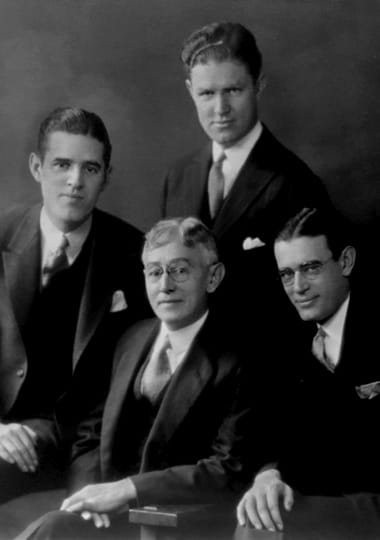
William Francis Denney [1869-1952] and his three sons: William Francis Denney Jr. [1895-1976], John D. Denney [1901-1967], and Anthony De Padua Denney [1903-1958]. Missing from the photo is William Denney’s daughter, Anna M. Denney [1899-1953].
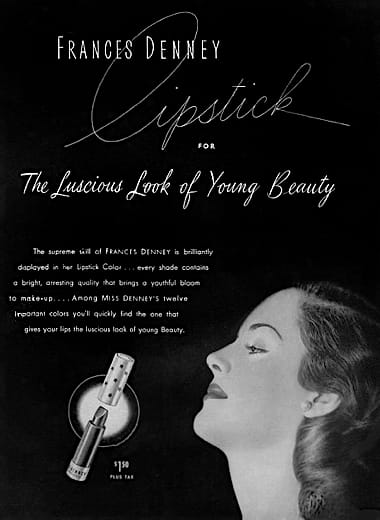
1945 Frances Denney Lipstick.
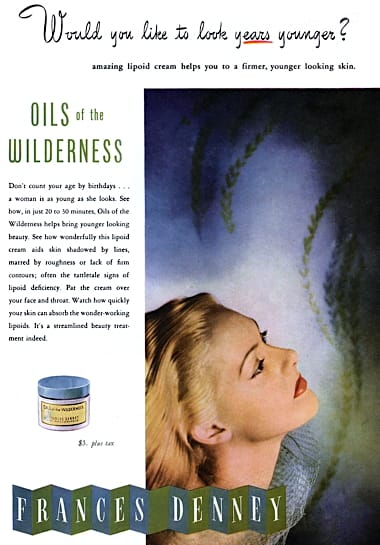
1946 Frances Denney Oils of the Wilderness.
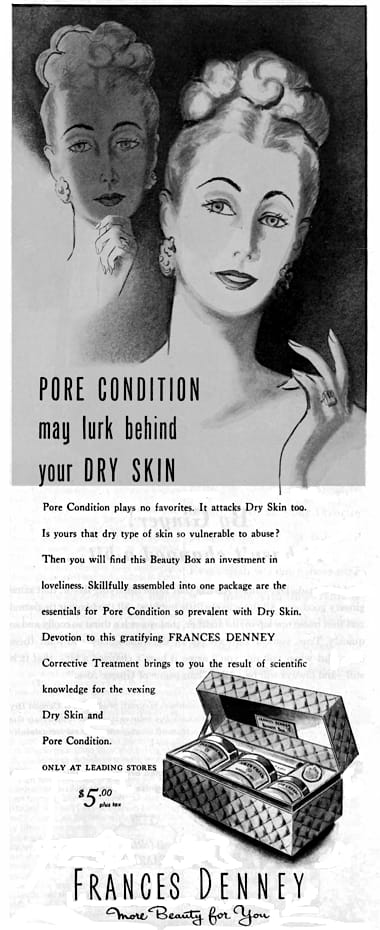
1946 Frances Denney Beauty Box for Dry Skin.
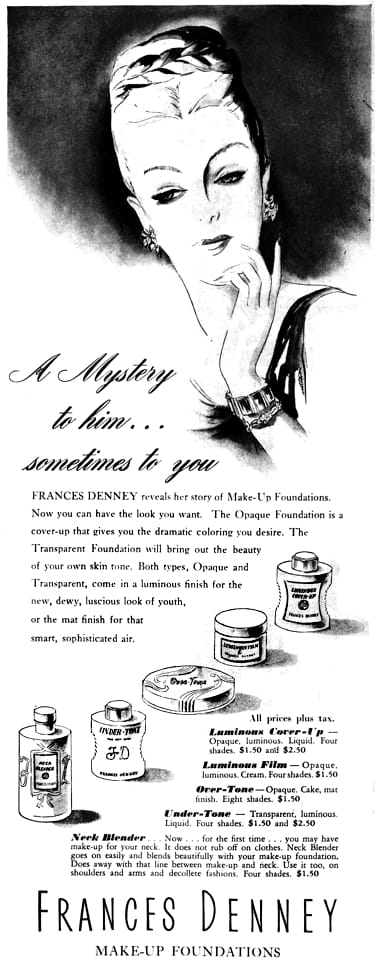
1946 Frances Denney Make-Up Foundations – Luminous Cover-Up, Luminous Film, Over-Tone, Under-Tone, and Neck Blender.
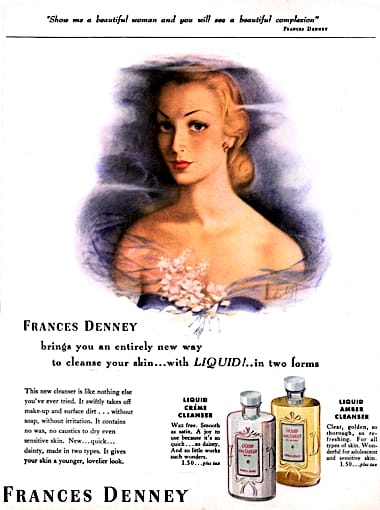
1947 Frances Denney Liquid Creme and Liquid Amber Cleansers.
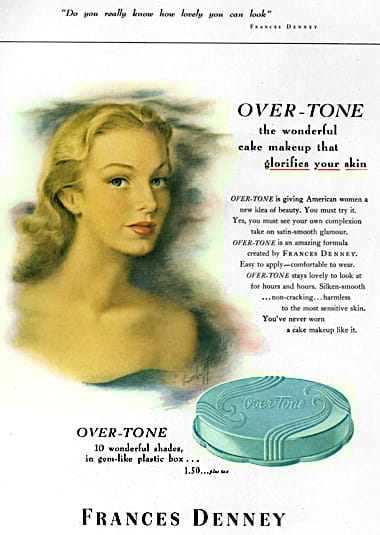
1947 Frances Denney Overtone in new packaging.
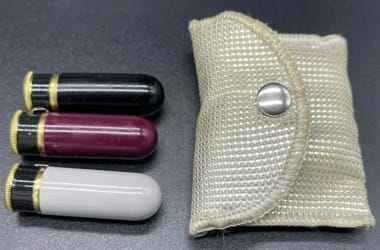
c.1948 Frances Denney 3 on a Match Lipsticks: Red Lilac, Coral, and Cyclamen shades.
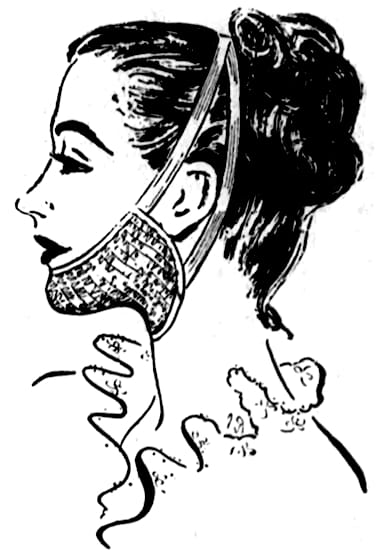
1949 Frances Denney Contour Chin Strap.

1950 Frances Denney Deep Down Cleansing Cream.
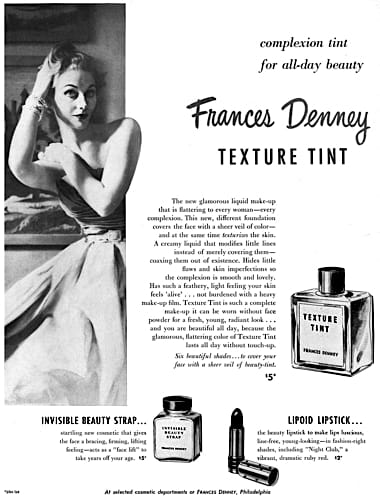
1951 Frances Denney Texture Tint.
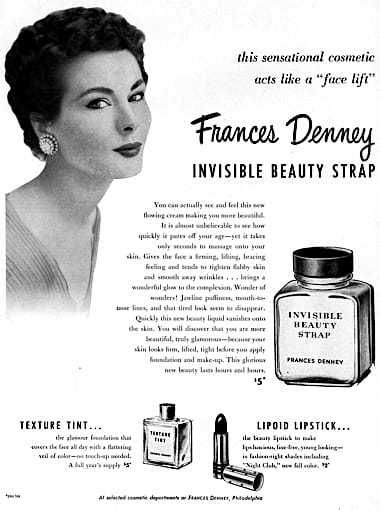
1951 Frances Denney Invisible Beauty Strap.
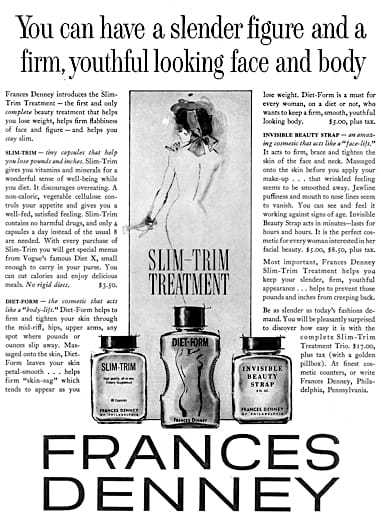
1954 Frances Denney Slim-Trim Treatment.

1954 Frances Denney Viva Cream.

1955 Frances Denney Constant Color Lipstick, Viva Fluid Make-up, and Face Powder.
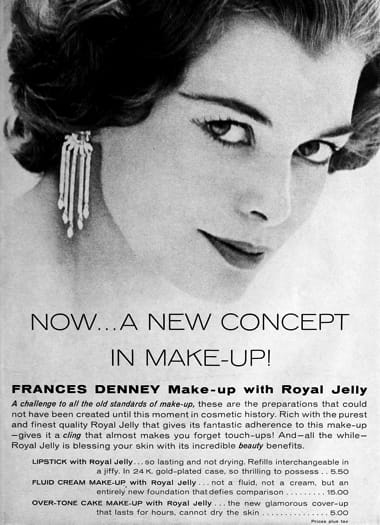
1957 Frances Denney Royal Jelly Make-up.

1958 Frances Denney Royal Jelly range.
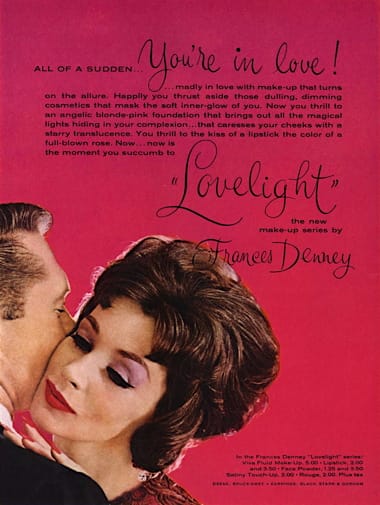
1960 Frances Denney Lovelight.

Robert Denney [1932-2021].
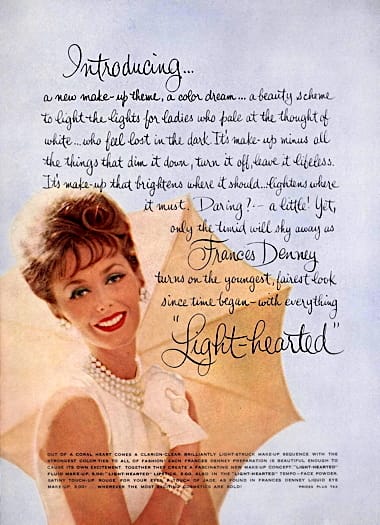
1960 Frances Denney Light-Hearted.

1961 Frances Denney New Life.
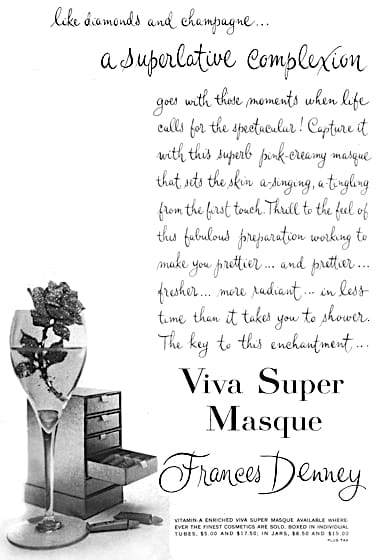
1961 Frances Denney Viva Super Masque.
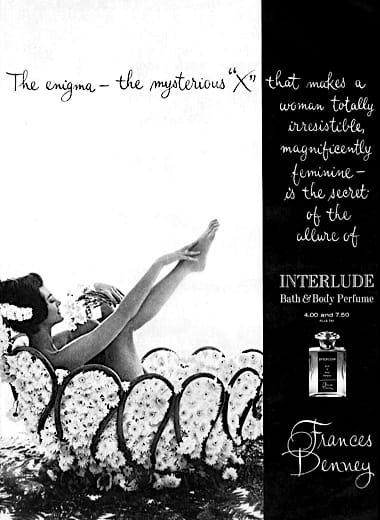
1962 Frances Denney Interlude Bath & Body Perfume.

1962 Frances Denney Multi-Layer Moisturizer, and Moisturizing Lipstick.
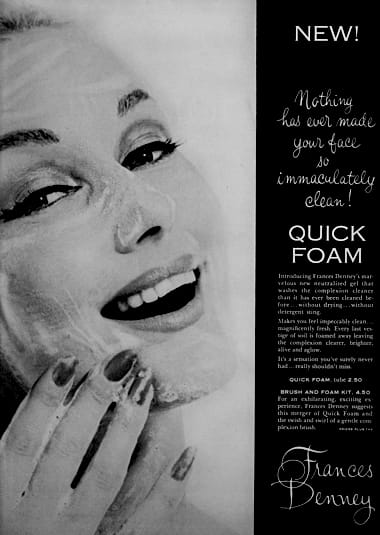
1962 Frances Denney Quick Foam.

1962 Frances Denney Metered Viva Fluid Make-up.

1963 Frances Denney Lustrous Make-up.

1963 Frances Denney Neo-Classic Night Cream.
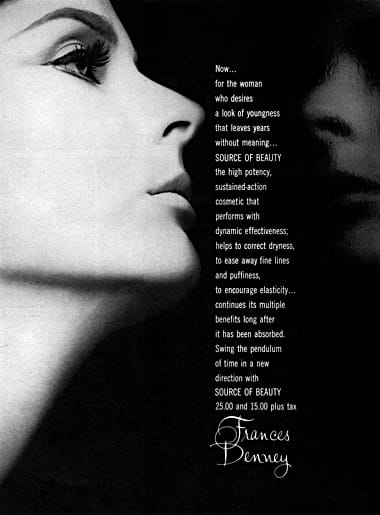
1964 Frances Denney Source of Beauty.

1964 Frances Denney ‘A Touch of Gold’.

1964 Frances Denney Source of Beauty Hair Products – New Life Shampoo, Hair Conditioner, Hair Rinse, Hair Set, and Hair Spray, scented with Interlude.

1965 Frances Denney Incandescent Make-up.

1965 Frances Denney Enchanting Eyes.
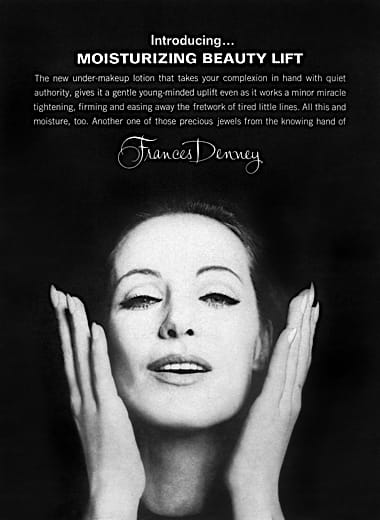
1966 Frances Denney Beauty Lift.
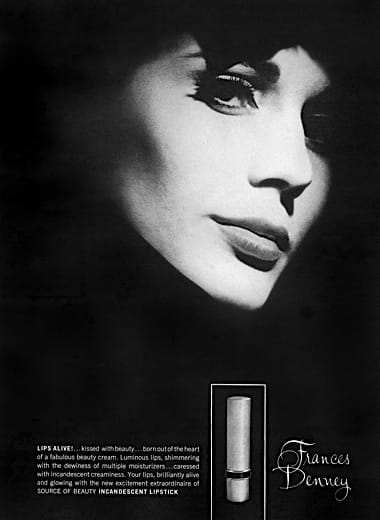
1966 Frances Denney Incandescent Lipstick in a Golden Colonnade case.
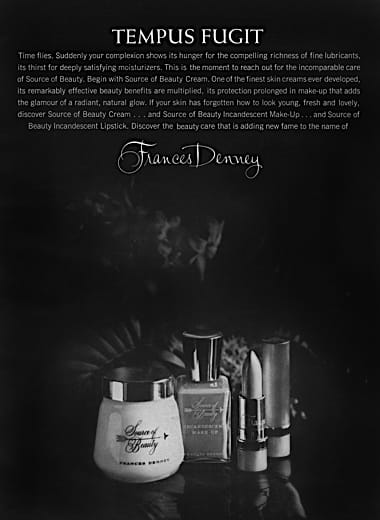
1966 Frances Denney Source of Beauty.

1966 Frances Denney Biscuit Make-up.
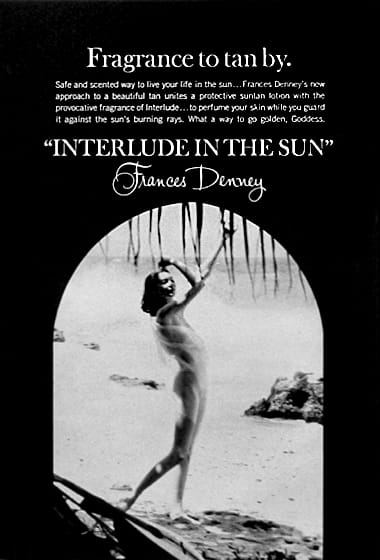
1967 Frances Denney Interlude in the Sun.
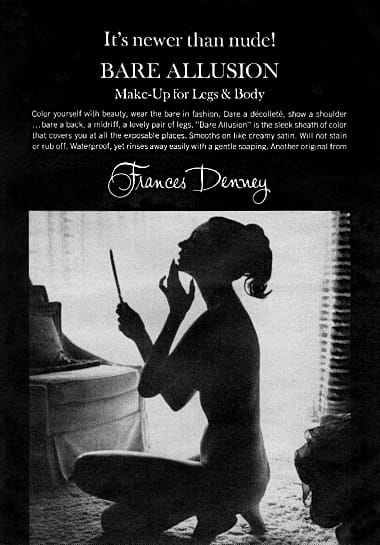
1967 Frances Denney Bare Allusion.

1967 Frances Denney Performing Lights using Incandescent Eye Lights, Incandescent Lip Lights, Incandescent Finishing Powder and Play-of-Light.
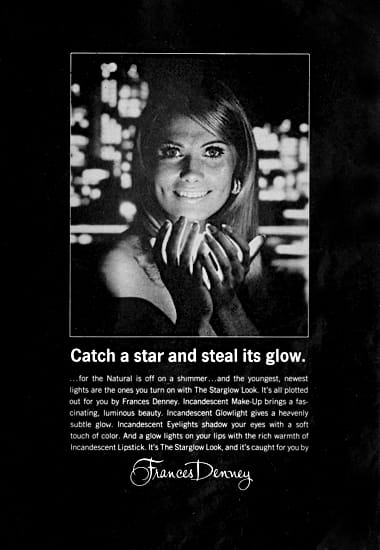
1967 Frances Denney Starglow look.

1968 Robert Denney range for men.
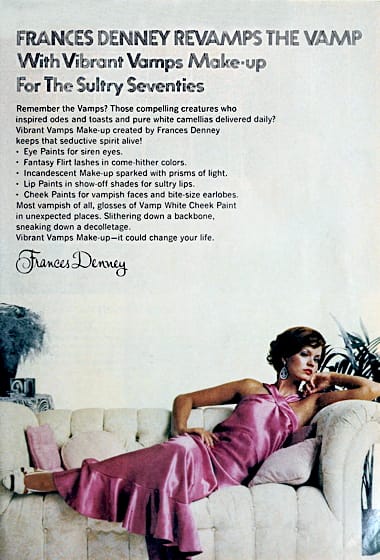
1970 Frances Denney Vibrant Vamps.
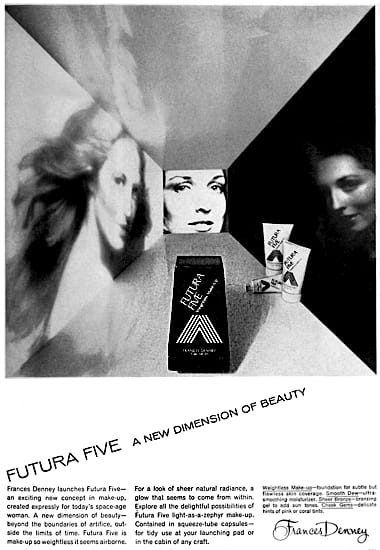
1970 Frances Denney Futura Five.
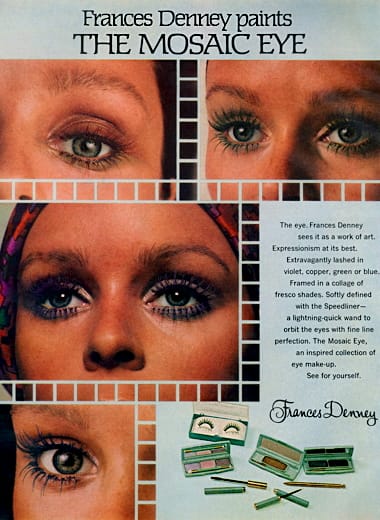
1971 Frances Denney Mosaic Eye.

1978 Frances Denney Interlude. The couple in the advertisement are William Michael Fine [1926-2013], president of Frances Denney and Susan Snyder Fine (née Payson) [b.1941] the company’s creative director.

1979 Frances Denney Adolpo. The Frances Denney name has been depreciated in favour of Denney.
